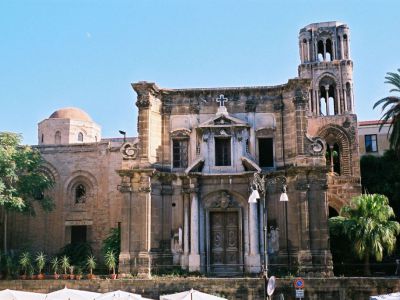
La Martorana (Martorana Church), Palermo (must see)
La Martorana is also known as The Church of Saint Mary of the Admiral. The admiral was George of Antioch, a Syrian Christian and principal minister of King Roger II of Sicily. George was not only the King's main man, he founded this Eastern Orthodox church.
The charter is dated from 1143 and written in ancient Greek and Arabic. Construction may have started before 1143 but the church was finished definitely by 1151. George died that same year. He and his wife are buried in the narthex of the church.
In 1193 or so Lady Eloisa Martorana moved in next door with her own division of Benedictine nuns. She established her convent which eventually took over the church, thus giving it the name "la Martorana." The nuns of Martorana created sugary treats in the form of fruit. The nuns have left but the Martorana fruit is still popular today.
The church has undergone architectural changes since it was built. The narthex houses the tombs of George and his wife. The campanile, elaborately constructed with arches and loggias, still is used as the main entrance.
The church is famous for its interior. A series of Byzantine mosaics are similar to those in the Palatine Chapel and Cefalu Cathedral. Mosaics on the walls show Roger II receiving the crown of Sicily from none other than Jesus. The dome over the nave has Byzantine images of Christ Pantokrator with saints, prophets and evangelists.
The charter is dated from 1143 and written in ancient Greek and Arabic. Construction may have started before 1143 but the church was finished definitely by 1151. George died that same year. He and his wife are buried in the narthex of the church.
In 1193 or so Lady Eloisa Martorana moved in next door with her own division of Benedictine nuns. She established her convent which eventually took over the church, thus giving it the name "la Martorana." The nuns of Martorana created sugary treats in the form of fruit. The nuns have left but the Martorana fruit is still popular today.
The church has undergone architectural changes since it was built. The narthex houses the tombs of George and his wife. The campanile, elaborately constructed with arches and loggias, still is used as the main entrance.
The church is famous for its interior. A series of Byzantine mosaics are similar to those in the Palatine Chapel and Cefalu Cathedral. Mosaics on the walls show Roger II receiving the crown of Sicily from none other than Jesus. The dome over the nave has Byzantine images of Christ Pantokrator with saints, prophets and evangelists.
Want to visit this sight? Check out these Self-Guided Walking Tours in Palermo. Alternatively, you can download the mobile app "GPSmyCity: Walks in 1K+ Cities" from Apple App Store or Google Play Store. The app turns your mobile device to a personal tour guide and it works offline, so no data plan is needed when traveling abroad.
La Martorana (Martorana Church) on Map
Sight Name: La Martorana (Martorana Church)
Sight Location: Palermo, Italy (See walking tours in Palermo)
Sight Type: Religious
Guide(s) Containing This Sight:
Sight Location: Palermo, Italy (See walking tours in Palermo)
Sight Type: Religious
Guide(s) Containing This Sight:
Walking Tours in Palermo, Italy
Create Your Own Walk in Palermo
Creating your own self-guided walk in Palermo is easy and fun. Choose the city attractions that you want to see and a walk route map will be created just for you. You can even set your hotel as the start point of the walk.
Historical Religious Buildings
Religion has always played an important role in the lives of the Italians – and the Sicilians are no exception. Thus, it is little wonder that the main city of the island, Palermo, boasts a plethora of religious buildings. The collection of historical churches found here ranges from the Arab-Norman-Byzantine to the Medieval, Gothic, Baroque and the Renaissance.
In the course of history, many... view more
Tour Duration: 2 Hour(s)
Travel Distance: 3.2 Km or 2 Miles
In the course of history, many... view more
Tour Duration: 2 Hour(s)
Travel Distance: 3.2 Km or 2 Miles
Palaces of Palermo
For centuries, Sicilian capital Palermo has been a focal point for the construction of noble dwellings and palaces. The latter were and still are a fine manifestation of the historical life in the region. They are a few hundred of them still in place, ranging chronologically from the medieval period to the first decades of the 20th century, and comprising an impressive collection of architectural... view more
Tour Duration: 1 Hour(s)
Travel Distance: 2.6 Km or 1.6 Miles
Tour Duration: 1 Hour(s)
Travel Distance: 2.6 Km or 1.6 Miles
Palermo Introduction Walking Tour
Around 8,000 BC, people called Sicani drew pictures in a cave outside Palermo. The scene shows a ritual sacrifice in the theatre. Was it a paleolithic foreshadowing of the temples, churches, and cathedrals to come?
The Sicani were succeeded by the Phoenicians. They made a settlement called Ziz which eventually became Palermo. But first, the Greeks, followed by the Carthaginians, followed by the... view more
Tour Duration: 2 Hour(s)
Travel Distance: 3.1 Km or 1.9 Miles
The Sicani were succeeded by the Phoenicians. They made a settlement called Ziz which eventually became Palermo. But first, the Greeks, followed by the Carthaginians, followed by the... view more
Tour Duration: 2 Hour(s)
Travel Distance: 3.1 Km or 1.9 Miles



